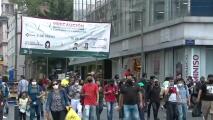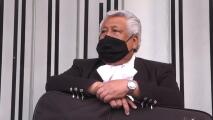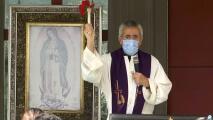What on earth happened in the Honduran elections?
Three weeks: That’s how long it took the Supreme Electoral Tribunal of Honduras to decide the outcome.

CANDIDATES
Juan O. Hernández
Salvador Nasralla
National Party
The Alliance
President
Opponent

CANDIDATES
Juan O. Hernández
Salvador Nasralla
National Party
The Alliance
President
Opponent

CANDIDATES
Juan O. Hernández
Salvador Nasralla
National Party
The Alliance
President
Opponent

CANDIDATES
Juan O. Hernández
Salvador Nasralla
National Party
The Alliance
Presidenta
Opponent
More than 20 dead in street protests and suspicions of electoral fraud. Two candidates claimed victory, but in the end, one was declared the winner: incumbent Juan Orlando Hernández, the candidate of the ruling National Party (NP).
 For weeks, The Alliance kept a victory celebration message on its website.
For weeks, The Alliance kept a victory celebration message on its website.
Official election data shows that Salvador Nasralla, the opposition Alliance candidate, led the election for most of the vote count. The trend changed dramatically after 68% of the vote was tallied.

Votes for NP
Votes for Alliance
42.98%
% of votes
40
41.38%
68%
of the vote
scrutinized
20
0
0
25
50
75
100
% of votes counted

Votes for NP
Votes for Alliance
42.98%
% of votes
40
41.38%
68%
of the vote
scrutinized
20
0
0
25
50
75
100
% of votes counted

Votes for NP
Votes for Alliance
42.98%
% of votes
40
41.38%
68%
of the vote
scrutinized
20
0
0
25
50
75
100
% of votes counted

Votos para NP
Votes for Alliance
42.98%
% of votes
40
41.38%
68%
of the vote
scrutinized
20
0
0
25
50
75
100
% of votes counted
Amid the protests and accusations of fraud that followed the election, an observer mission team of the Organization of American States (OAS) disqualified the results in the face of what it called "irregularities and deficiencies.”
The report included the technical analysis of Georgetown University professor Irfan Nooruddin. His conclusion was even more emphatic: "On the basis of this analysis, I would reject the proposition that the National Party won the election legitimately."
Nooruddin analyzed the difference in votes between the two parties during the recount. The following graph shows the drop in the number of votes for the Alliance after 68% of the count.
The further to the right the line is, the greater the advantage of the Alliance candidate during the counting of votes. The further to the left, the greater the advantage of the National Party candidate.

How to read this graphic
The horizontal axis shows the difference of percentage points between both candidates.
2
0
0
Nasralla + 5
Hernández + 2
100

How to read this graphic
The horizontal axis shows the difference of percentage points between both candidates.
2
0
0
Nasralla + 5
Hernández + 2
100

Difference of votes in favor of Alliance
Difference of votes in favor of NP
2
0
2
4
0
Alliance begins to distance itself.
% of votes
counted
25
50
Change in the trend.
68%
75
Nasralla loses 3.5 points advantage.
100
2
4
0
2
Nearly 50,000 votes in favor of PN.

Difference of votes in favor of Alliance
Difference of votes in favor of NP
2
0
2
4
0
Alliance begins to distance itself.
% of votes
counted
25
50
Change in the trend.
68%
75
Nasralla loses 3.5 points advantage.
100
2
4
0
2
Nearly 50,000 votes in favor of NP.

Difference of percentage points between candidates
Change in the trend.
4
Difference of votes in favor of Alliance
2
Nasralla loses 3.5 points advantage.
Alliance begins to distance itself.
0
Difference of votes in favor of NP
Nearly 50,000 votes in favor of NP.
2
68%
50
75
0
100
25
% of votes counted

Difference of percentage points between candidates
Change in the trend.
4
Difference of votes in favor of Alliance
2
Alliance begins to distance itself.
Nasralla loses 3.5 points advantage.
0
Difference of votes in favor of NP
Nearly 50,000 votes in favor of NP.
2
68%
50
75
0
100
25
% of votes counted
The OAS technical analysis explained that this fall in a candidate’s vote is theoretically possible.But the same pattern is repeated in many of the country's departments where support for the Alliance fell almost simultaneously.
Then there were other unusual aspects to the vote count, says Nooruddin, such as an unusual increase in voter participation late in the count, well above the average.

The trend skyrocketed after 68% of the vote count.
57.5%
The average participation during the election was 57.5%.
100
68%
0
50
% of votes counted

The trend skyrocketed after 68% of the vote count.
57.5%
The average participation during the election was 57.5%.
68%
100
0
50
% of votes counted

The trend skyrocketed after 68% of the vote count.
57.5%
The average participation during the election was 57.5%.
100
68%
0
50
% of votes counted

The trend skyrocketed after 68% of the vote count.
57.5%
The average participation during the election was 57.5%.
100
68%
0
50
% of votes counted
Theodore Dale Vukanovich, head of the company that processed and transmitted the results, said the change is explained by votes coming in from rural areas.
Dale Vukanovich says that Nasralla's advantage began to fall after the second day of counting with the arrival of the rural votes on November 28 and 29 -as the following graph shows.
After the closing of the voting centers, the lack of internet or electricity in some rural areas meant that many precinct tallies had to be sent by trucks to the capital instead of transmitting them digitally, which caused the count to be delayed. According to Dale Vukanovich, most of that vote favored the ruling party candidate.

Votes for NP
Votes for Alliance
Votes in rural areas (in thousands)
600
300
No data
available
0
day 26
27
28
29
30
1
2
3
4
Days of count (from November 26)
Votes in urban areas (in thousands)
600
300
No data
available
0
day 26
27
28
29
30
1
2
3
4
5
Days of count (from November 26)

Votes for NP
Votes for Alliance
Votes in rural areas (in thousands)
600
300
No data
available
0
day 26
27
28
29
30
1
2
3
4
Days of count (from November 26)
Votes in urban areas (in thousands)
600
300
No data
available
0
day 26
27
28
29
30
1
2
3
4
5
Days of count (from November 26)

Votes for NP
Votes for Alliance
Votes in rural areas (in thousands)
Votes in urban areas (in thousands)
600
600
300
300
No data
available
No data
available
0
0
day 26
27
28
29
30
1
2
3
4
5
day 26
27
28
29
30
1
2
3
4
Days of count (from November 26)
Days of count (from November 26)

Votes for NP
Votes for Alliance
Votes in rural areas (in thousands)
Votes in urban areas (in thousands)
600
600
300
300
No data
available
No data
available
0
0
day 26
27
28
29
30
1
2
3
4
5
day 26
27
28
29
30
1
2
3
4
Days of count (from November 26)
Days of count (from November 26)
A manipulated vote count?
Both the president of the Supreme Electoral Court, David Matamoros, and Dale Vukanovich defend the validity of the electoral process.
 Theodore Dale Vukanovich, manager of the company in charge of the transmission of the results | David Adams
Theodore Dale Vukanovich, manager of the company in charge of the transmission of the results | David Adams
"I want everyone to know that electronic vote fraud was impossible, and that can be demonstrated," Dale Vukanovich told Univision.
But there are suspicions. One of the theories about what happened was presented in a detailed 66-page report by the group GANAS USA (Group of North American Friends in Software), which accessed a sample of the precinct tallies stored on the official server. Their analysis argued that some showed signs of electronic modification.
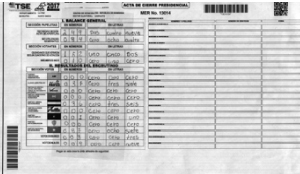 According to GANAS, this tally sheet, 13014, processed on Nov 27 bore no signatures. | GANAS
According to GANAS, this tally sheet, 13014, processed on Nov 27 bore no signatures. | GANAS
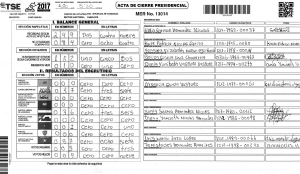 The same tally sheet appears in the system days later, on Nov 30, this time with signatures. | GANAS
The same tally sheet appears in the system days later, on Nov 30, this time with signatures. | GANAS
The analysis concluded that in some of the records it appears that the original scanned information was deleted and new data was included. The OAS acknowledged one of its reports that it did not find "concrete actions with the purpose of intentionally altering" the results. But, it also stressed that the system the Honduran government used was not secure enough.
